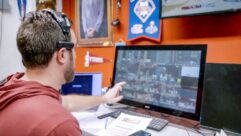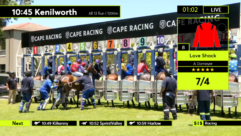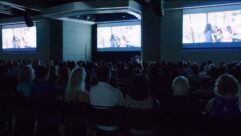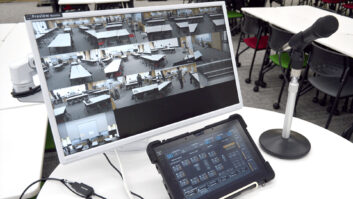Oslo, Norway, September 2012
… The Sofiemyr church in Oslo is a striking modern building, with bare brick walls, a tiled floor and wooden ceiling. Light pours in from a huge stained glass window and other windows in the corners.
The audio solution, supplied by Benum A/S, is equally striking, with a pair of inverted IC Live arrays, flown from the ceiling alongside the matching subwoofers, above a small performance stage. The technique has been used before – England’s Stage Audio Services was possibly first to experiment with it, flying a pair of IC Live arrays upside down at trim height for a standup comedy tour of UK theatres, which allowed the beams to be angled at the ground floor audience as well as the balconies. But this is almost certainly the world’s first permanent installation to use the configuration, which has many benefits in a tall space.
Geir Kristoffersen, manager of the consulting department of COWI for Acoustics and Electro Acoustics, Sound and Vision, who designed the system for the church and frequently mixes it, explains: “This room is a cube, essentially, 16 by 16 metres with a height of about 12 metres, so it’s very interesting acoustically. But it’s turned 90 degrees so that you get some angles towards the speakers.” Slots in the ceiling provide low frequency absorption.
Although on the face of it a highly reverberant space, the actual reverb time is just 1.7 seconds with a very well controlled low end. “But still, 1.7 seconds is significant,” he points out. However, the bare brick walls are an inevitable challenge in view of their capability to deliver slapback echo to the stage.
The church is also equipped with a pipe organ, which is quite frequently played together with a band and a grand piano, as well as a movable pulpit, which is taken out during modern-style worship services.
“The loudspeaker system is flown in the form of a pair of Renkus-Heinz IC Lives,” says Kristoffersen. “We’re very happy with the sound of it. In fact, I’ve never worked with a system that’s so easy and quick to get good sound out of,” he says.
“It works exceptionally well for this kind and size of room and with such a wide variety of music. Together with the choir, we often have a worship team of eight people singing with their vocal microphones. Last Sunday, for example, the choir was seated directly in front of the loudspeakers and I had my measurement system at the desk and I was pumping 90db A weighted but flat out it was giving 101dB. Yet there was no issue with feedback,” he continues.”With these digitally steerable arrays we get tightly controlled beams, which allow us to deflect the sound away from these noisy brick walls,” he explains, adding, “While there is some reverberation, of course, if you shoot straight into these walls then you’d have a big problem with slapback.”
The system is configured with two beams from each IC Live, one pair aimed at the front part of the congregation, the others at the rear. The result, saysA Kristoffersen, “is that the sound is completely uniform wherever you are standing or sitting.”
“What I like the most about this system – and I’ve worked with good systems all my life – is that because it’s a true line array and not a banana hang it creates a cylindrical wave, which means that it doesn’t excite the room as much as a traditional three-box system, which would have been our obvious alternative,” he says, and adds, “Another thing is that, with a choir, the choir bench is high, which means the microphones are right in front of the loudspeakers, yet we have never had any feedback problems. Because it’s so even sounding across the frequency spectrum you don’t get response spikes which then become the problem, especially with the choir-mic scenario.”
Tuning is performed using both RHAON and in an Allen & Heath IDR8 DSP processor with an Allen & Heath T112 control surface, allowing it to be controlled from two different places.
A small delay system provides extra coverage into a small annexe at the rear and in the side halls, using CFX-61R cabinets, again controlled over RHAON and CobraNet. These are matched with six CF-121M cabinets for monitors, which can also be deployed as a portable PA in the larger side room of the church, or outside during the summer.
He continues, “It’s also very good for the monitoring because despite it being so loud up there it doesn’t feedback even when it’s rock’n’roll loud. Also,” he adds, “we work a lot with the grand piano and, for me, a grand piano has to sound good. If the grand piano doesn’t sound good then it’s nearly worse than having the drum kit not sounding right, but even when we’re pushing rock’n’roll levels and there’s a monitor there next to it, if you do push it to feedback it’s not high-end feedback but a just rumble, which tells you that the total room is just playing too loud. It’s very impressive and we’re extremely happy.”
###
Headquartered in Foothill Ranch, California, Renkus-Heinz, Inc. is the worldwide leader in the design and manufacture of audio operations networks, digitally steerable arrays, powered and non-powered loudspeakers, system specific electronics and fully integrated Reference Point Array systems.










